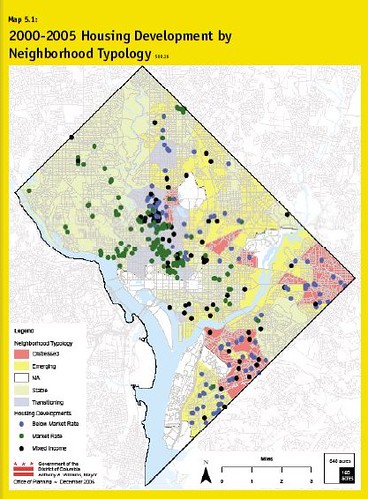Backwards thinking on housing policy: renters vs. owners

Figure from the Housing Element of the DC Comprehensive Land Use Plan
The Washington City Paper Housing Complex blog reports, in "Marion Barry wants to ban apartment buildings in Ward 8" that former Mayor and Ward 8 Councilmember Marion Barry is concerned about the mix of housing offered in Ward 8 because:
"Renters, by their very nature, don't keep up their neighborhoods like homeowners would," Barry tells me. "Renters will allow drug dealers in the neighborhood. It's a fact. It's a doggone fact."
While I don't focus that much on housing policy generally, lately I have been considering more deeply the problem of single use zoning as it relates to building robust and resilient neighborhoods.
Barry also says this:
"The American dream is to own a home. And black people have not gotten the American dream as much as they need to," Barry says. "Somebody can rent for 20 years, and has no equity in their unit at all."
And that's the real point. And banning apartment buildings doesn't address that reality.
That being said, Councilmember Barry is likely right that Ward 8 has an imbalance of types of housing which doesn't always serve the ward, its stability and its ability to improve.
1. Developing a housing policy for the Ward* (and for the City**) focused on providing a variety of types of housing and a variety of types of "land tenure" systems would be the first course of action, complemented by other policies and programs including:
2. Developing programs to build civic identity within renters so that they are "better neighbors." (kind of like a "Neighborhood Housing Services" program for renters, Neighborhood Housing Services of Chicago, );
3. Develop programs to assist renters in saving money so that they can purchase housing. One such program is lease-option ("rent to own");
4. Provide different types of land tenure and ownership systems such as co-operative housing, co-housing (one of the first in the U.S. is in Takoma DC), and separating housing ownership from land ownership through land trust relationships, to reduce the cost of housing overall;
5. At the same time, provide capacity building assistance to organizations and individuals so that they can manage housing in these kinds of relationships--it's a lot harder to collectively manage a property than it is to manage a single property.
* Note that DC's Housing Element reads pretty well, but it doesn't get at the "granular" level in terms of diversity of housing types within neighborhoods and at more fine grained policy, although the fine grain of policy and actions should really come from a separate Housing Master Plan anyway, because the Housing Element of the Comp. Plan is supposed to set the overall goals, policies, and objectives, and the Master Plan the specifics.
Labels: affordable housing, housing market, housing policy, neighborhood planning, urban design/placemaking, urban revitalization



0 Comments:
Post a Comment
<< Home